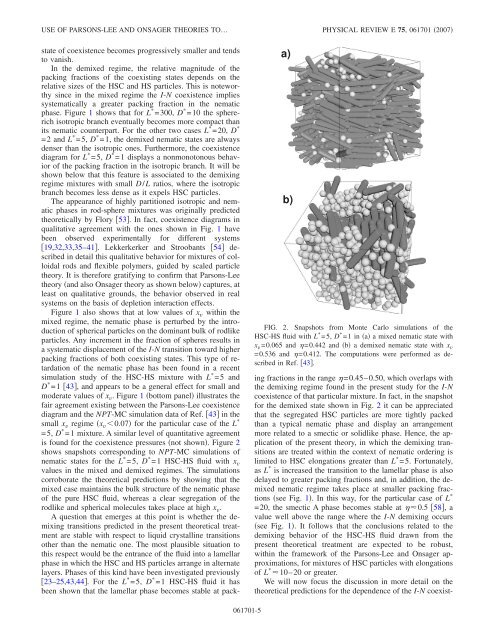Use of Parsons-Lee and Onsager theories to - APS Link Manager ...
Use of Parsons-Lee and Onsager theories to - APS Link Manager ...
Use of Parsons-Lee and Onsager theories to - APS Link Manager ...
Create successful ePaper yourself
Turn your PDF publications into a flip-book with our unique Google optimized e-Paper software.
USE OF PARSONS-LEE AND ONSAGER THEORIES TO…ing fractions in the range =0.45–0.50, which overlaps withthe demixing regime found in the present study for the I-Ncoexistence <strong>of</strong> that particular mixture. In fact, in the snapshotfor the demixed state shown in Fig. 2 it can be appreciatedthat the segregated HSC particles are more tightly packedthan a typical nematic phase <strong>and</strong> display an arrangementmore related <strong>to</strong> a smectic or solidlike phase. Hence, the application<strong>of</strong> the present theory, in which the demixing transitionsare treated within the context <strong>of</strong> nematic ordering islimited <strong>to</strong> HSC elongations greater than L * =5. Fortunately,as L * is increased the transition <strong>to</strong> the lamellar phase is alsodelayed <strong>to</strong> greater packing fractions <strong>and</strong>, in addition, the demixednematic regime takes place at smaller packing fractionssee Fig. 1. In this way, for the particular case <strong>of</strong> L *=20, the smectic A phase becomes stable at 0.5 58, avalue well above the range where the I-N demixing occurssee Fig. 1. It follows that the conclusions related <strong>to</strong> thedemixing behavior <strong>of</strong> the HSC-HS fluid drawn from thepresent theoretical treatment are expected <strong>to</strong> be robust,within the framework <strong>of</strong> the <strong>Parsons</strong>-<strong>Lee</strong> <strong>and</strong> <strong>Onsager</strong> approximations,for mixtures <strong>of</strong> HSC particles with elongations<strong>of</strong> L * 10–20 or greater.We will now focus the discussion in more detail on thetheoretical predictions for the dependence <strong>of</strong> the I-N coexista)b)PHYSICAL REVIEW E 75, 061701 2007FIG. 2. Snapshots from Monte Carlo simulations <strong>of</strong> theHSC-HS fluid with L * =5, D * =1 in a a mixed nematic state withx v =0.065 <strong>and</strong> =0.442 <strong>and</strong> b a demixed nematic state with x v=0.536 <strong>and</strong> =0.412. The computations were performed as describedin Ref. 43.state <strong>of</strong> coexistence becomes progressively smaller <strong>and</strong> tends<strong>to</strong> vanish.In the demixed regime, the relative magnitude <strong>of</strong> thepacking fractions <strong>of</strong> the coexisting states depends on therelative sizes <strong>of</strong> the HSC <strong>and</strong> HS particles. This is noteworthysince in the mixed regime the I-N coexistence impliessystematically a greater packing fraction in the nematicphase. Figure 1 shows that for L * =300, D * =10 the sphererichisotropic branch eventually becomes more compact thanits nematic counterpart. For the other two cases L * =20, D *=2 <strong>and</strong> L * =5, D * =1, the demixed nematic states are alwaysdenser than the isotropic ones. Furthermore, the coexistencediagram for L * =5, D * =1 displays a nonmono<strong>to</strong>nous behavior<strong>of</strong> the packing fraction in the isotropic branch. It will beshown below that this feature is associated <strong>to</strong> the demixingregime mixtures with small D/L ratios, where the isotropicbranch becomes less dense as it expels HSC particles.The appearance <strong>of</strong> highly partitioned isotropic <strong>and</strong> nematicphases in rod-sphere mixtures was originally predictedtheoretically by Flory 53. In fact, coexistence diagrams inqualitative agreement with the ones shown in Fig. 1 havebeen observed experimentally for different systems19,32,33,35–41. Lekkerkerker <strong>and</strong> Stroobants 54 describedin detail this qualitative behavior for mixtures <strong>of</strong> colloidalrods <strong>and</strong> flexible polymers, guided by scaled particletheory. It is therefore gratifying <strong>to</strong> confirm that <strong>Parsons</strong>-<strong>Lee</strong>theory <strong>and</strong> also <strong>Onsager</strong> theory as shown below captures, atleast on qualitative grounds, the behavior observed in realsystems on the basis <strong>of</strong> depletion interaction effects.Figure 1 also shows that at low values <strong>of</strong> x v within themixed regime, the nematic phase is perturbed by the introduction<strong>of</strong> spherical particles on the dominant bulk <strong>of</strong> rodlikeparticles. Any increment in the fraction <strong>of</strong> spheres results ina systematic displacement <strong>of</strong> the I-N transition <strong>to</strong>ward higherpacking fractions <strong>of</strong> both coexisting states. This type <strong>of</strong> retardation<strong>of</strong> the nematic phase has been found in a recentsimulation study <strong>of</strong> the HSC-HS mixture with L * =5 <strong>and</strong>D * =1 43, <strong>and</strong> appears <strong>to</strong> be a general effect for small <strong>and</strong>moderate values <strong>of</strong> x v . Figure 1 bot<strong>to</strong>m panel illustrates thefair agreement existing between the <strong>Parsons</strong>-<strong>Lee</strong> coexistencediagram <strong>and</strong> the NPT-MC simulation data <strong>of</strong> Ref. 43 in thesmall x v regime x v 0.07 for the particular case <strong>of</strong> the L *=5, D * =1 mixture. A similar level <strong>of</strong> quantitative agreementis found for the coexistence pressures not shown. Figure 2shows snapshots corresponding <strong>to</strong> NPT-MC simulations <strong>of</strong>nematic states for the L * =5, D * =1 HSC-HS fluid with x vvalues in the mixed <strong>and</strong> demixed regimes. The simulationscorroborate the theoretical predictions by showing that themixed case maintains the bulk structure <strong>of</strong> the nematic phase<strong>of</strong> the pure HSC fluid, whereas a clear segregation <strong>of</strong> therodlike <strong>and</strong> spherical molecules takes place at high x v .A question that emerges at this point is whether the demixingtransitions predicted in the present theoretical treatmentare stable with respect <strong>to</strong> liquid crystalline transitionsother than the nematic one. The most plausible situation <strong>to</strong>this respect would be the entrance <strong>of</strong> the fluid in<strong>to</strong> a lamellarphase in which the HSC <strong>and</strong> HS particles arrange in alternatelayers. Phases <strong>of</strong> this kind have been investigated previously23–25,43,44. For the L * =5, D * =1 HSC-HS fluid it hasbeen shown that the lamellar phase becomes stable at pack-061701-5
















